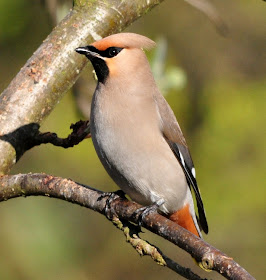I had my first decent lie-in for months this morning and only got up at around 9am. After lounging about for a while I decided I should get out for a couple hours as it was forecast to rain in the afternoon. It was too late and too breezy to go to any of my usual ringing sites so I went to a very sheltered stretch of the river Douglas to see if there were any juvenile Dippers about.
I had just made my way down to the river when a Blackbird flew out of a steep section of bank. I thought the Blackbird may have been foraging but something made me have a closer look. On a earth ledge about three quarters up the bank there was a nest with 4 small young. The young were about 2 days old as they were still naked and blind. The outer part of the nest was largely constructed from small pieces of root which helped to camouflage the nest.
 |
| Spot the Blackbird nest |
 |
| 2 day old Blackbirds |
 |
| Nest location. Did you spot it? |
This bank is quite unstable and prone to collapse when the river levels are high but it looks like this section had collapsed not too long ago so hopefully there will be no further collapses for a while. I have found a few Blackbird nests on ledges in outbuildings but this is the first I have found in a river bank. I will check the nest in a few days to see how they are getting on.
I put a net across another section of the river while I checked out the areas up and down stream. I had seen Dippers carrying food a couple of weeks ago so I hoped the nesting attempt had been successful and the young had fledged by now. I didn't see any young Dippers or any adults carrying food but I did see a Grey Wagtail carrying food and a Mallard with some recently hatched ducklings. I was just about to pack up because the first few drops of rain had arrived when this Dipper turned up in the net. It was a new bird and its wing length showed it was a male.
 |
| male Dipper |
The rain put a stop to any further survey work so I returned home having spent an interesting couple of hours on the river. I then spent the rest of the day as I started it and just lounged about. It is nice to slow life down and be really lazy now and again and that certainly sums up today.










































